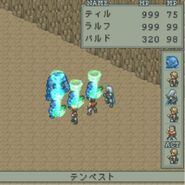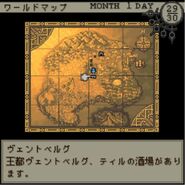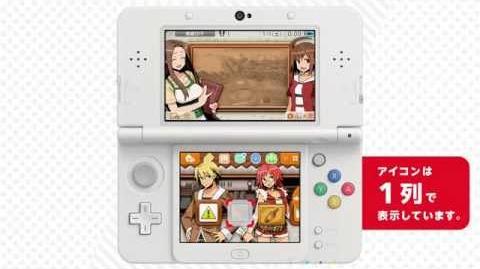| Adventure Bar Story | |
|---|---|
 App image in iOS & Android | |
|
Developer(s) |
Rideon |
|
Publisher(s) |
RideonJapan (iOS, Android) |
|
Platform(s) |
Mobile phone, iOS, PSP, Android, 3DS |
|
Release date |
2006-08-03 Mobile
JP 2006-08-03 (BREW au version) JP 2008-11-06 (Yahoo! Mobile & docomo i-αppli versions) Mobile (game version 2) JP 2009-03-26 (BREW au version) JP 2009-04-03 (docomo i-αppli version) JP 2009-04-15 (Yahoo! Mobile) iOS JP 2011-06-17 NA 2012-03-08 PSP JP 2011-07-12 Android JP 2012-02-08 NA 2012-07-30 3DS JP 2014-06-25 NA 2015-02-19 EU 2015-03-26 |
Adventure Bar Story, known in Japanese as Fushigi no Kuni no Boken Sakaba (不思議の国の冒険酒場) and also known in the first versions as Adventure bar of Wonderland, is a role-playing video game (RPG) developed by Japanese company Rideon (the first version was co-developed with GignoSystem Japan).
The game was released as a digital game with no physical counterpart by RideonJapan in Japanese mobile phones for au's BREW, Yahoo! Mobile and docomo's i-αppli, and later in iOS and Android, by Rideon in the Japanese Nintendo eShop for Nintendo 3DS and in the Japanese PlayStation Store for the PlayStation Portable (PSP), and by Hong Kong based company Circle Entertainment in the Nintendo eShop for North America and Europe.
Adventure Bar Story has a distinctive feeling from other RPGs due to the successful combination of cooking and adventuring.
Versions[]
The original game, under the title Fushigi no Kuni no Boken Sakaba: Series of Wonderland 2nd (不思議の国の冒険酒場 Serise[sic] of Wonderland 2nd), was first available in Japan for mobile phones on 3 August 2006 for au's BREW and a couple of years later, it was also released for the Japanese mobile phone environments SoftBank's Yahoo! Mobile and docomo's i-αppli on 6 November 2008.[1]
While the English title might seem to imply that it is the first game, the more well-known version of the game is in fact based on the sequel Fushigi no Kuni no Sakaba 2: Series of Wonderland 5th (不思議の国の酒場2 Series of Wonderland 5th).[note 1][2] This version introduced the most well known characters, story and setting from the series. The sequel, like the original version, was also first released for au's BREW on 26 March 2009 and then for docomo's i-αppli on 3 April 2009 and SoftBank's Yahoo! Mobile on 15 April 2009.
After some time, an improved version of the sequel, but with the title of the first game minus the Series of Wonderland subtitle, was released for iOS on 17 June 2011, for PSP on 12 July 2011 and on 8 February 2012 for Android in Japan. In these versions, the translated name used for the game is Adventure bar of Wonderland, making reference to the original Japanese titles in which the games were part of a series of thematically-related games developed by Rideon of which part one of this game was the second and part two was the fifth to be released, as implied by the Japanese subtitle of the games. The PSP version also has the moniker Portable (ポータブル) added at the end of the title of the game.
In its English edition, the name of the game was changed to Adventure Bar Story, no longer attached to the other Wonderland games with which it was originally associated. The game, originally brought with the help of ZigZaGame,[3] was released in North America on 8 March 2012 for iOS and 30 July 2012 for Android.
Almost two years after the English release, a revised and improved version of the game with new character art was released for the Nintendo 3DS in Japan on 25 June 2014, three years after the original release. This 3DS version was later released outside Japan by Circle Entertainment in North America on 19 February 2015 and Europe on 26 March 2015.
Story[]
The game puts you in charge of a restaurant in a fantasy world with adventurers. In order to get more mats and recipes to create more dishes, the player has to visit to caves, ruins, forests, stores in faraway towns, and dangerous dungeons where monsters appear. Using the ingredients collected, the player prepares and discovers new recipes to sell in the menu of the store and to compete in the cooking contests to improve sales and the rank of the store.
In the first version, the main character is a boy called Till (ティル) who inherits the store after his father dies from an unexpected accident three years prior the start of the game. After overcoming the grief of losing his father, he vows to fulfill his father's desire to make the bar a successful business.
In the second and most well known version, the sisters Siela and Kamerina run unsuccessfully Kamerina's Bar (originally named Schpeck Schenke or Schpeck Tavern (酒場シュペック亭, Sakaba Schpeck Tei)) after the death of their parents. When the shady owner of the most successful restaurant in the town, Gustav, tries to buy their establishment by driving them out of business, Siela takes charge of the cooking duties that until then were the responsibility of her poorly cooking skilled sister. With the help of her close friend and main supplier Fred, Siela embarks on an adventure to make Kamerina's Bar the best restaurant in the Cassel Kingdom and to defeat Gustav's Cassel Garden by collecting different mats and recipes around the different locations in the kingdom.
After preparing Apple Pie, Alfine joins the party. After increasing the rank of the bar and when Gustav starts his counteroffensive, a regular patron of the bar, Alter offers his assistance to overcome the challenges ahead. Eventually, the reputation of the bar unexpectedly attracts the attention of a hungry thief, Lidia, who gets caught by Siela, but Siela, instead of punishing her, offers her a job with regular meals and a place to stay, which Lidia accepts.
Meanwhile, Alfine's fellow wizard student, Elias falls behind Alfine after being the top student for a long time due to Alfine increasingly becoming the better magician thanks to the practical experience gained by adventuring with Siela. This prompts Elias to ask Siela to also take him on her adventures so that he can also gain practical experience.
During this time, the Queen has paid close attention to Kamerina's Bar increasing reputation and performances at cooking competitions, becoming a fan of Siela. After achieving the top rank and defeating Cassel Garden by winning the cooking contest at the top level, Siela, as the top chef in the kingdom, gets invited to the castle to cook, but the Queen gets sick. Siela offers her help to try to gather the rare mats and to cook an ancient recipe that is said could be able to cure the Queen.
After much effort, Siela manages to obtain three of the four ingredients. The last one, the Holy Fruit, can only be gotten by traveling to the forbidden area of the Purple Forest where it was said that the Amiella used to live. In this forest, Siela finds the Amiella Milija, and rescues her from being sacrificed. However, by doing so, Siela causes the desperation of the Amiella because Milija was supposed to be a sacrifice for the Dragon Lord so that it spared the Amiel Villa from complete destruction.
Having overcome all previous challenges including a Basilisk, Siela offers to destroy the Dragon Lord in exchange of getting a Holy Fruit. The Village Head agrees to this, although he doubts that it's even possible. After successfully defeating the Dragon Lord, Siela returns to Amiel Villa with the remains of the Dragon Lord and is given a Holy Fruit with which she comes back to Casselburg and prepares the Soup of Life.
After a couple of days of administering the Soup of Life, the Queen is fully healed and Siela learns that the Village Head of Amiel Villa came to Casselburg to thank Siela for defeating the Dragon Lord that terrorized them for centuries and the restore relationships with humans. It is then revealed that the schism between the Amiella and humans was caused when a prince of the humans rescued his beloved, an Amiella, from being sacrificed to the Dragon Lord by taking her place. This caused a rift as the Dragon Lord was furious with the exchange retaliated against the Amiella, and the humans thought that their prince was sacrificed by the Amiel. As it turns out, the prince rescued his beloved because she was carrying his daughter, the now Queen. Being half Amiella, she needed to eat Holy Fruit once in a while to sustain her health. Since the ties were cut and a cover story was made up to protect the Queen from being hated for being part Amiella, it was not until Siela provided the Holy Fruit in the Soup of Life that the Queen finally eat the fruit.
Because of her actions and her already high reputation as the top chef in the kingdom, the King is about to name them the Royal Chef when Gustav barges in to tell the King that, although Siela is talented, she is of humble origins and couldn't possibly be the Royal Chef. But other people who had been wronged by Gustav and whom Siela helped, also arrive to denounce Gustav. The King, having learned of Gustav actions during the Queen's convalescence, orders his incarceration and the closure of Cassel Garden. Thus, Siela becomes the Royal Chef and Kamerina's Bar is the top restaurant in Cassel Kingdom.
Development[]
Fushigi no Kuni no Boken Sakaba: Series of Wonderland 2nd (不思議の国の冒険酒場 Serise[sic] of Wonderland 2nd) was the first version of the game released in 2006. This edition was developed by Rideon and GignoSystem.[1] However, it is the sequel first released in 2009, Fushigi no Kuni no Sakaba 2: Series of Wonderland 5th (不思議の国の酒場2 Series of Wonderland 5th), that became the most popular and the basis for the iOS, Android and handheld systems versions. This version, while inspired by the basis created by GignoSystem, was developed solely by Rideon.[2]
Developer company Rideon has consistently looked to created unique RPGs. According to Kenichi Sonoda, producer at Rideon, Adventure Bar Story was planned with the idea of creating an RPG game that had elements from a simulation management and a regular RPG.[3] While this may seem as a copy of indie title Recettear: An Item Shop's Tale, Adventure Bar Story was in fact first released more than a year before the former. Sonoda has commented that balancing the RPG elements with the simulation management was a challenge. One example of this is that achieving objectives in the simulation management portion unlocks RPG events.
The original game Fushigi no Kuni no Boken Sakaba was fleshed out and improved with the sequel Fushigi no Kuni no Sakaba 2. Both of these games were developed for Japanese mobile phones prior to iPhone's dominance in that country. The iOS and PSP versions released in 2009 became the basis for the more well known edition of the game, which in turn is based in the second iteration of the game.
For the 3DS version released in 2014, the game was once again redesigned and improved. The most notable change is the new character art that has since being used in material related to the series. It also has an improved user interface, facial expressions for the characters, the possibility of select a party with any formation (all previous version required Siela to forcibly hold a spot in the party at all times), a new balance of dish prices and recipe hints to make more enjoyable the management aspect of the game and, an adjustment of the balance in battle to more properly fine-tune the power and skill of the characters.
Gameplay[]
Adventure Bar Story plays like a regular RPG with a classical turn-based system in battles.
The main objective of the game is to successfully manage the bar by preparing dishes, adventuring in dungeons and fulfilling requests. Regular items and equipment work similar to other RPGs. They can be found in dungeons, bought in stores, stolen from enemies or by defeating them.
The magic system depends on experience points gained in different categories by defeating monsters. The categories are Physical, Fire, Water, Wind and Earth. There is also Light and Dark, although these are only used for attack and resistance in certain spells, monsters and equipment, not as experience points. Different dungeons have different type of monsters, which in turn have different characteristics and give different types of magic experience. To unlock new skills, a character must gather enough magic experience points from different categories.
A unique feature of the game is the level up system: instead of gaining experience points by defeating enemies to increase a character's level, the character must eat food. The characters have a limit to how much they can eat per in-game day. The different types food give different levels of satiation and experience. The best food requires rarer ingredients or mats as they are called in the game. In order to get mats, the player can buy them from the stores or find them in the dungeons. As the story progresses more store and dungeons are available, meaning more mats.
Another important aspect are the recipes for the food. It is not enough to get mats. A player must know the recipe to prepare a dish. Recipes can be found by talking to a random non-player character (NPC), opening chests, stealing from monsters, or by experimentation. The game also gives hints depending on certain conditions to make it easier to discover recipes.
Besides gaining levels by eating food, the dishes are also used to be sold by the bar and to participate in competitions. These two tasks are essential to both advance the story and gain money to buy mats and items. As the bar gains ranks with by getting higher sales and winning competition points, more dungeons and mats become available. The player must manage adequately the needs of the bar and the needs of the characters experience in order to progress in the game.
Reception and sequels[]
The reception of the game in all versions has been positive. It has a 4.4 of 5 in user reviews in Google Play and around the same in customer ratings for all revisions in the iTunes Store, along with a 5 of 5 ranking for the latest iteration for iOS. The PSP version has a 5 star ranking from users in the Japanese PlayStation Store.
The iOS version as of March 2016 holds a ranking of 72 in Metascore and 8.3 in user score in Metacritic.
For the 3DS version, as of March 2016, the game holds a ranking of 69 in Metascore and 8.3 of user score in Metacritic. Dylan Newcome of Nintendo Life commented positively on the game saying "though at first glance cooking and adventuring seem like two concepts that wouldn't mix well, they actually combine to make quite a tasty treat". RPGamer's Sam Wachter expressed that, while the game as its flaws, he couldn't deny the amount of hours he spent into the game and the enjoyment it gave him.
The success of the game in its handheld incarnations lead to the release of the spin-off game Adventure Bar Labyrinth.
Gallery[]
Videos[]
Notes[]
- ↑ Notice that the Boken (冒険 Adventure) part of the first game's title is removed in the mobile sequel
References[]
- ↑ 1.0 1.1 "商品紹介 — 不思議の国の冒険酒場" [Product introduction — Fushigi no Kuni no Boken Sakaba] (in Japanese). Rideon Games. Retrieved 2016-03-06.
- ↑ 2.0 2.1 "不思議の国の酒場2" [Fushigi no Kuni no Sakaba 2] (in Japanese). Rideon Games. Retrieved 2016-03-07.
- ↑ 3.0 3.1 "Adventure Bar Story Interview: Making And Localizing A Mobile JRPG". Siliconera. 2012-02-10. Retrieved 2016-03-07.
External links[]
- Official website at Rideon Games (Japanese)
iOS version
- Official website for the iOS version at Rideon Games (Japanese)
- Official English website at Rideon Games
- App at the iTunes store
PSP version
- Official website for the PSP version at Rideon Games (Japanese)
- Game profile at the PlayStation Store (Japanese)
Android version
- Official website fro the Android version at Rideon Games (Japanese)
- Official English website at Rideon
- App at Google Play
3DS version
- Official website for the 3DS version at Rideon Games (Japanese)
- Game profile at Nintendo Japan (Japanese)
- Game profile at Nintendo of America
- Game profile at Nintendo UK















